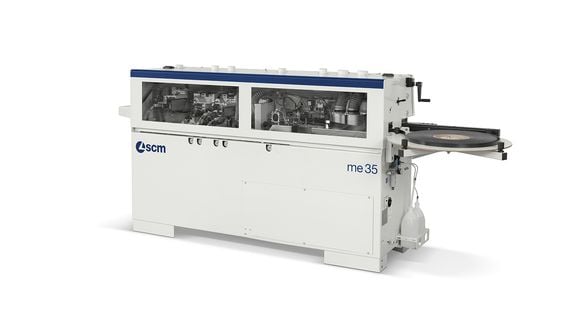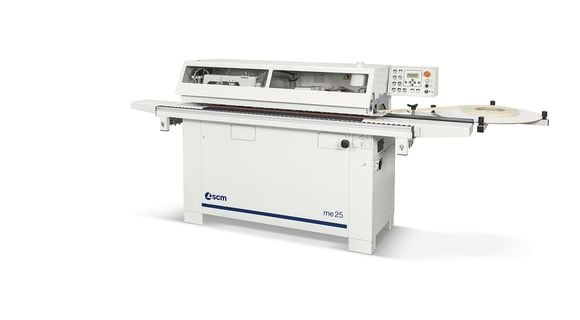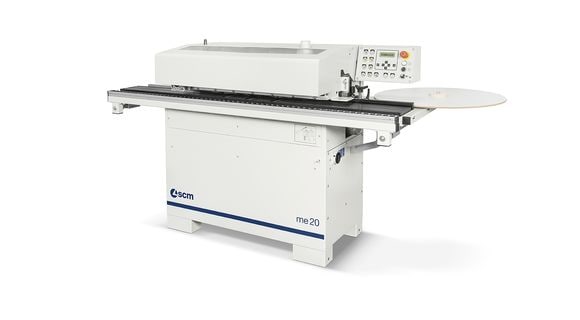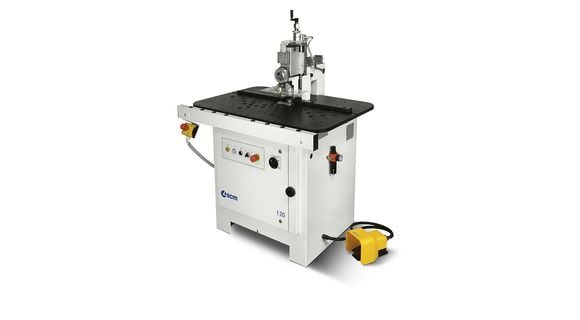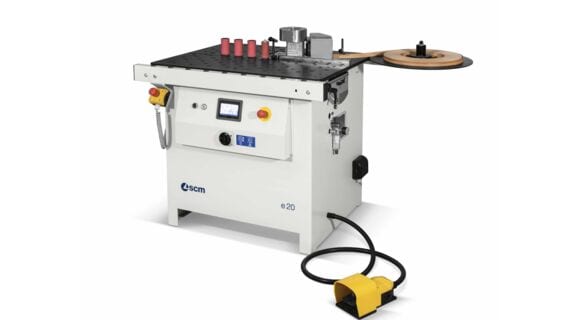Edge banders
The SCM woodworking machinery encompasses all the technologies for woodworking, craft work and industry.
SCM edgebanders found in the woodworking machines category are simple, complete automatic edgebanders with the option of gluing edges in strips of 5mm solid wood, features which make them top of the range solutions in the category for craftsmanship woodwork.
Why would I choose a SCM edgebander?
A tradition of excellence. Since 1952 Minimax has always led the way and been at the forefront of innovative solutions for small shops with big shop needs. Practical, compact and robust, these are straight forward edgebanders, designed to do their job with ease and precision. They are also easy to maintain. Gain the edge with Minimax.
Read moreWhat is the minimum panel thickness possible?
It ranges from 8mm (0.32”) to 16mm (0.63”) panel thickness depending on model.
Read moreWhat is the maximum panel thickness possible?
50mm (1.97”) panel thickness for all Minimax edgebanders.
Read moreWhich edgebanders have premill? How much material can you take off?
The ME 28T, ME 35T, and ME 35TR use shims to adjust the infeed fence for 0.5/1/1.5/2mm stock removal options. The ME 40T has a manually adjustable infeed fence that allows for 0 – 2mm stock removal. All of these units come with an exhaust hood and air blower that cleans the panel from dust and chips.
Read moreCan I replace my glue pot? Can I use different types or colors of glue?
You can with the ME 35 and ME 40. We recommend the ME 35TR edgebander that comes with an interchangeable glue pot allowing the user to easily remove and install the glue pot bin in just a few minutes. If you need an additional glue pot, the ME 40T is an edgebander with an interchangeable glue pot that also comes with a spare glue pot that can be used for different gluing applications. You can switch glue colors, however Minimax edgebanders are setup for the industry standard EVA adhesives. There is also a glue pot for Polyurethane glues available for me 35 and me 40.
Read moreWhich edgebander do you recommend for my shop? What are the differences?
ME 20 – Glue pot unit, 2mm guillotine end trimming unit, top/bottom trim units with a belt feed system. Available in single-phase. Band thicknesses of 0.4 – 2mm. This is a 2 hour cycle machine time.
The ME 20 is as simple as it gets for a glue pot edgebander, and would do well in shops that use PVC and/or wood tape, producing a few jobs per month with no need to apply solid wood strips or high pressure laminates on a regular bases.
ME 25 – Glue pot unit, 3mm special radius end trimming unit, top/bottom trim units, edge scrape and buffing units with belt feed system. Available in single-phase. Band thicknesses of 0.4 – 3mm and up to 5mm wood strips with loading kit. This is a 2-3 hour cycle machine time.
The ME 25 is one of our more popular edgebanders, able to handle thicker tapes, plastic laminate and 5mm wood strips. It will come with the buffing and scraping station and wood strip feeder unit. A great edgebander for smaller shops looking to do several jobs a month.
ME 28T – Glue pot unit, single pre-mill motor, 3mm special radius end trimming unit, top/bottom trim units, edge scrape and buffing units with belt feed system. Available in single-phase. Band thicknesses of 0.4 – 3mm. This is a 2-3 hour cycle machine time.
Has all of the ME 25 units, only now we added the pre mill unit for shops that have difficulty with clean edges when they cut their panels.
ME 35T – Glue pot unit, dual pre-mill motors, 3mm special radius end trimming unit, top/bottom trimming unit, edge scrape, glue scrape, and buffing units with track feed system. Available in single-phase and 3-phase. Band thickness 0.4 – 3mm and up to 5mm wood strips with loading kit. This is a 3-4 hour cycle machine time.
With the ME 35 we start to get into edgebanders for shops seeking more production and features. This machine features high frequency motors, two head pre-milling and radius end trimming, for shops looking at running the machine every day, but still not break the bank.
ME 35TR – Interchangeable glue pot unit, panel edge heating device, anti-adhesive unit, dual pre-mill motors, 3mm corner rounding end trimming unit, top/bottom trimming unit, edge scrape, glue scrape, and buffing units with track feed system. Available in 3-phase. Band thicknesses of 0.4 – 3mm and up to 3mm wood strips. This is a 3-4 hour cycle machine time.
This award winning edgebander is truly revolutionary. Built on the production platform of the ME 35, you now get a machine with an interchangeable glue pot, that can do full corner rounding, and do it at a bargain, not to mention it comes with an anti-adhesive unit!. You would normally have to spend nearly twice as much to get these features anywhere else.
ME 40T – Interchangeable and spare glue pot, dual pre-mill motors, 3mm special radius end trimming unit, top/bottom trimming unit, edge scrape, glue scrape, and buffing units, with track feed system. Available in single-phase and 3-phase. Band thicknesses of 0.4 – 3mm and up to 5mm wood strips with loading kit. This is a 5-6 hour cycle machine time.
If speed and production describes your shop’s needs, but you still have a budget to keep, the ME 40T could be the perfect edgebander for you. It has an interchangeable glue pot, and comes with a spare glue pot, will do everything the ME35T is capable of on an even faster track feed system.
Read moreWhat are the different forms of edgebanding?
Edge banding can be made of various materials such as Wood, PVC, ABS, PP, PMMA, WVE, etc.
PVC is the most commonly used in the manufacture of edgebands for the furniture industry due to its excellent processing characteristics. For modular furniture, PVC edge banding is very popular as is extremely durable, simple to fix and has an extremely long life.
ABS (acrylonitrile butadiene styrene) shares most of PVC characteristics, but ABS is lower in density, does not include chlorine in its composition and is not flame retardant.
PP (Polypropylene) PP is a semi-crystalline plastic used regularly in the packaging industry. It is excellent for small radius applications, is chlorine-free and is popular as an alternative to the traditional PVC and ABS materials used in the furniture industry.
PMMA is a high-grade thermoplastic material. The transparency of the acrylic exceeds that of glass.
Wood Veneer Edgebanding is produced by joining individual pieces of veneer together into a continuous master roll by finger-jointing the veneer. Veneer refers to thin slices of wood. Popular species include oak, maple, mahogany, ash and walnut but there are lots more including natural and dyed veneers.
Read moreWhat is the difference between EVA and PU/PUR hotmelt adhesive?
Hotmelt adhesives are used for bonding endings in plastic or wood. Both adhesives are based on plastic: EVA hotmelt on Ethyl-Vinyl Acetate (abbreviated: EVA), while PU/PUR hotmelt is based on polyurethane (abbreviated: PU/PUR). Edgebanding using EVA-hotmelt is still the most common for nearly all cabinet/furniture applications. If the joints need to be particularly water or heat resistant then you may consider using PU/PUR adhesive as this has a significantly higher water and heat resistance than EVA.
Read more

